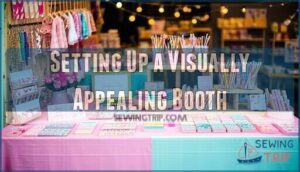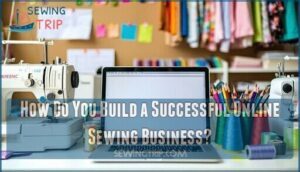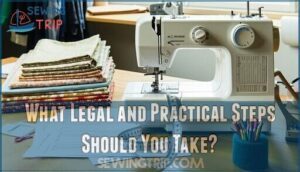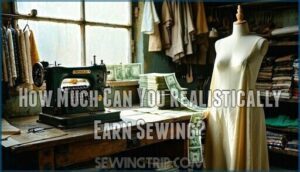This site is supported by our readers. We may earn a commission, at no cost to you, if you purchase through links.

People crave unique pieces that tell a story, and they’re willing to pay for quality craftsmanship. If you’ve got solid sewing skills and some business savvy, turning your thread and fabric into real income isn’t just possible—it’s happening right now.
The key lies in finding your niche, pricing smartly, and tapping into multiple revenue streams that keep money flowing even when your machine isn’t running.
Table Of Contents
- Key Takeaways
- Why Can Sewing Be a Profitable Career?
- What Sewing Niches Offer The Most Income?
- How Can You Earn Money Teaching Sewing?
- What Are The Best Ways to Sell Handmade Items?
- How Do You Build a Successful Online Sewing Business?
- What Legal and Practical Steps Should You Take?
- How Much Can You Realistically Earn Sewing?
- What Skills and Qualities Lead to Sewing Success?
- Frequently Asked Questions (FAQs)
- Conclusion
Key Takeaways
- You can absolutely build a six-figure sewing business by finding your niche (alterations, bridalwear, home decor, or pet accessories), pricing strategically to cover materials and labor, and creating multiple income streams like teaching classes, selling on Etsy, or offering custom services.
- The handmade market is booming because customers crave unique, ethically-made pieces with real stories behind them, and they’re willing to pay premium prices for quality craftsmanship over mass-produced alternatives.
- Success requires both technical sewing skills and strong business fundamentals—you’ll need to master marketing, customer service, SEO, social media presence, and legal requirements like business registration and insurance to stand out in a competitive market.
- Average sewing income starts around $18/hour but varies wildly based on your specialization, location, skill level, and whether you’re doing freelance work or running a full business, with specialized niches like bridal alterations commanding significantly higher rates.
Why Can Sewing Be a Profitable Career?
If you’ve ever wondered why sewing is more than just a hobby, you’re in the right place. There are real reasons people can actually earn a solid income from it today.
Sewing offers real earning potential—here’s why it works.
Growing Demand for Handmade and Custom Goods
If you’ve ever felt that thrill when someone asks, “Did you make that yourself?” you already know there’s a growing appetite for handmade and custom goods. The Artisan Economy is booming, and here’s why people can’t get enough:
- Custom Products feel special.
- Ethical Consumption matters.
- Unique Gifts stand out.
- Small-Batch Production means quality.
- Handmade items tell a story.
Textile Industry Trends and Opportunities
This isn’t your grandma’s textile world—today, textile businesses are booming thanks to Digital Transformation and Regional Growth. Sustainable Materials and ethical production are hot topics, with Automation Impact making production smarter.
The Circular Economy is catching fire, too, letting you carve out a niche market in sustainable fashion or creative customization. Sewing now means new opportunities wherever you look!
The industry is experiencing growth, with the textile market expanding considerably.
Multiple Income Streams for Sewists
As sewing opportunities expand, you’ll naturally want to explore multiple income streams from your craft.
Income diversification means combining approaches—service bundling, subscription boxes, product licensing, or online classes that generate passive revenue.
Earning money sewing isn’t just one-size-fits-all anymore!
What Sewing Niches Offer The Most Income?
If you’re looking for the sewing gigs that really pad your bank account, some specialties stand out above the rest. The key is finding a niche that fits your skills, your style, and local demand.
So where’s the money? Let’s break down the sewing specialties that actually pay.
Alteration and Tailoring Services
Imagine this: every wedding, prom, and family gathering is a chance for you to shine. Alteration and tailoring services are the heart of sewing income—think garment fitting, bridal alterations, and keeping Formal Wear sharp. Reliable repair services and custom tailoring give you steady work. Your skills solve real-life wardrobe “emergencies”—and people gladly pay for peace of mind. One avenue to explore is custom dressmaking services, which can command high prices.
- Garment fitting for tricky body shapes
- Bridal alterations, from hem to bustle
- Formalwear alterations to rescue last-minute changes
- Repair services for everyday clothing
- Custom tailoring for style that actually fits
Custom Clothing and Bridalwear
If you dream of sewing couture that truly matters, bridalwear design and formal wear never go out of style. Custom fittings, intricate bridal alterations, and unique maternity sewing fetch premium prices, especially for exclusive boutiques.
A sewing business built on custom sewing work—like individual bridal wear and accessories—allows you to tackle creative custom sewing projects with freedom and real financial reward.
Home Decor and Upholstery
Looking for steady, high-ticket work? Custom furniture and drapery projects blend creativity with profit; upholstery margins often reach 30–50%.
Restoration projects and interior design services mean repeat customers, no two jobs alike.
Material costs can be steep, but smart pricing and customization keep revenue streams flowing for any upholsterer. A sewing business in home decor delivers genuine earning power—and serious creative satisfaction.
Pet Accessories and Niche Items
When you dive into pet accessory trends, custom pet apparel and handmade pet toys are absolute goldmines. Unique niche items—think bow ties for beagles or sustainable pet products—fly off the shelves.
With pet owners enthusiastic for handmade crafts, a sewing business focused on pet accessories and niche items will find plenty of fans, both locally and through an Etsy shop.
How Can You Earn Money Teaching Sewing?
If you’ve ever thought about sharing your sewing skills, teaching can be surprisingly rewarding.
You can turn your knowledge into steady income in several ways. Here are some options to consider.
Hosting Sewing Camps and Classes
Ever thought your love for sewing could fill a room with laughter, learning, and a steady side income, all at the same time? Hosting sewing camps and classes is your ticket. Here’s how to get rolling:
- Curate creative camp themes and design a flexible curriculum.
- Embrace classroom management for all student skill levels.
- Protect yourself—always secure liability insurance!
Offering Private Lessons and Workshops
If you’ve ever wished you could skip the big crowd and really see that “aha!” moment light up in someone’s eyes, offering private sewing lessons and workshops might be just the thing.
You can design a Beginner Curriculum, tackle Complex Techniques, and adjust your Pricing Strategies.
With smart Workshop Promotion and great Student Retention, teaching sewing classes doubles as both connection and income.
Creating and Selling Sewing EBooks
Who says your sewing know-how has to stay in your sewing room when you can bundle it into an easy-to-sell eBook and share it with stitchers everywhere?
Cover eBook content like pattern design or troubleshooting tips, and turn your PDF sewing patterns into digital income.
Use smart digital marketing, set a fair pricing strategy, and stay sharp about copyright issues and royalties with online sales.
What Are The Best Ways to Sell Handmade Items?
Getting your handmade items into the hands of happy customers takes more than just great sewing skills. If you want your work to stand out and actually sell, you’ll need a smart approach.
Here’s how to get noticed—and paid.
Craft Fair and Farmers Market Strategies
While getting into the craft fair business, don’t just book any event with “craft” in its name—smart market selection matters. Schedule around local events and steer toward fairs with free parking and steady foot traffic.
Plan your product pricing ahead, study seasonal trends, and treat customer engagement as the secret sauce that turns curious browsers into buyers of your handmade crafts for sale.
Setting Up a Visually Appealing Booth
Once you’ve chosen the right fair, your booth setup is where you get to let your creativity shine and stop shoppers in their tracks.
Play with booth layout and table dressing so your handmade items pop, add lighting effects for drama, and get clever with signage design.
Smart product placement helps make your craft fair business memorable—and boosts actual selling, too!
Building a Cohesive Product Line
Mixing random projects feels tempting, but a true Target Audience wants to recognize your Brand Identity instantly. Keep Style Consistency with a signature Color Palette across handmade items—think matching zipper pulls or seasonal collections that tell a story.
Whether it’s your Etsy shop or local fair, a clear product direction helps your handmade product sales feel polished, not piecemeal.
How Do You Build a Successful Online Sewing Business?
Taking your sewing business online can open doors you never knew were there. You’ll need more than great stitches to make your shop stand out.
Let’s look at what matters most.
Selling on Etsy and Other Marketplaces
Everyone wants more freedom—selling on Etsy and other online shops can actually provide it. Mastering Etsy SEO and Product Photography gives your handmade items a fighting chance. Here’s what matters:
- Understand Marketplace Fees before pricing.
- Find your Niche Selection sweet spot.
- Prioritize eye-catching Product Photography.
- Gather positive Customer Reviews.
- Tweak your online selling strategies often.
SEO and Branding for Online Shops
If you want shoppers to actually find—and remember—your online shop, you’ll need a little strategy and a dash of personality in your SEO and branding. Smart sellers mix Niche Selection, Keyword Research, Brand Voice, and Visual Branding, weaving together a shop as memorable as their best quilt. Here’s how the ingredients stack up:
| Ingredient | Why It Matters |
|---|---|
| Niche Selection | Stands out from copycats |
| Keyword Research | Powers Etsy SEO |
| Brand Voice | Makes every listing feel like “you” |
| Visual Branding | Catches eyes, builds trust |
| Customer Engagement | Turns browsers into fans |
Social Media and Influencer Partnerships
Ever wonder how your favorite sewing brands seem to pop up everywhere online, making even the most ordinary pincushion look like a must-have accessory? That’s the magic of smart Platform Selection and Content Strategy mixed with a dash of Audience Engagement.
Influencer Outreach and thoughtful social media marketing—especially Instagram marketing—help build real buzz and community, boosting Partnership ROI and sales.
What Legal and Practical Steps Should You Take?
Before you start sewing for a living, there are a few practical boxes you’ll want to check. Think about what the law expects, what tools you really need, and how to set fair prices.
Let’s walk through the basics as you’re starting out.
Business Registration and Local Regulations
Before you make your first sale, you’ll need to handle some essential business fundamentals that keep your sewing operation legal and professional.
Whether you’re working from home or renting space, having these basics covered protects you and your business.
Make sure you check:
- Business licensing rules,
- Zoning compliance for your workspace,
- Sales tax obligations (especially with ecommerce),
- Insurance needs and contract law basics for sewing business ideas.
Equipment and Workspace Requirements
Setting up your sewing space is a bit like building your own creative playground—every tool and corner has a job to do, and it all adds up to smoother, happier sewing days.
Invest in sturdy tables for Workspace Ergonomics, prioritize Lighting Needs, and organize Fabric Storage and Pattern Storage.
Regular Machine Maintenance means fewer breakdowns and more time creating revenue from your homebased business or small business sewing ideas.
Pricing and Cost Calculation
Putting a price on your sewing work can feel a bit like guessing what’s inside a mystery box—so let’s make sure you don’t sell yourself short. Always include:
- Material Costing and Labor Rates: your time is gold!
- Overhead Expenses—think thread, rent, even snacks.
- Wise Profit Margins and Competitive Pricing—keep that income steady, and watch your revenue climb with every retail price!
How Much Can You Realistically Earn Sewing?
Curious what kind of paycheck you could pull in with your sewing skills? Let’s talk real numbers, what shapes those earnings, and where your work might be worth the most.
Before you crunch your own numbers, there are a few key factors worth understanding.
Average Hourly and Annual Earnings
Did you know needlework can actually pay the bills? In the U.S., sewing jobs bring home $18 an hour on average, but Salary Percentiles show earnings jump with experience or specialization.
Regional Pay varies—Maryland’s close to national rates—while International Wages lag behind.
Curious about boosting your income? Freelance sewing jobs and creative sewing business ideas make earning money online possible, too.
Factors Affecting Sewing Income
Of course, your take-home pay with a needle and thread isn’t just about the hours you put in—it all depends on what you sew, who you sew for, and even how you price your skills.
Skill level, niche demand, and smart marketing efforts shape your income.
Material costs, time investment, and clever sewing business ideas all affect how much you make.
Regional Differences and Specializations
Your location has a big say in your sewing paycheck. In spots like California and New York—true industry hubs—regional wages jump thanks to higher niche demand and the pull of export markets. Some places reward specialties like custom sewing work or alteration services more. Here’s what changes with your zip code:
- Regional wages can vary dramatically
- Industry hubs host higher-paying jobs
- Niche demand boosts pay for custom clothing and seamstress skills
- Urban areas offer more opportunities for specialization
- Export markets favor regions with skill variations
What Skills and Qualities Lead to Sewing Success?
Sewing for a living takes more than knowing how to thread a machine or finish a seam. The real secret comes down to the skills and habits you bring to the table, both in your craft and your business.
Here’s what actually sets successful sewists apart.
Technical Sewing and Design Skills
When you develop strong technical sewing and design skills, you’ll find your creativity can really take the lead—and clients will notice the difference. Mastering garment construction and pattern making gives your work structure and polish.
Choosing fabrics wisely, using draping techniques, caring for your machine, and designing sewing patterns help you stand out, whether it’s clothing design or costume work.
Marketing and Customer Service Abilities
Once your sewing skills are sharp, it’s your knack for connecting with people and sharing your story that turns curious shoppers into loyal, repeat customers.
Smart Client Communication, honest Brand Storytelling, and a strong Online Presence work together for powerful customer retention.
Mix in Feedback Integration and creative social media marketing for businesses, and your customer base will grow—just like your confidence.
Adapting to Industry Changes and Trends
The textile world shifts fast, so staying curious about new fabrics, tech, and what customers want keeps your sewing business fresh and competitive. Embrace sustainable practices and digitalization impact—think eco-friendly materials and smart machines.
Personalization growth and circular economy models open new income streams, while exploring diverse sewing business ideas and ecommerce business models helps you build multiple incomes that weather any trend.
Frequently Asked Questions (FAQs)
What are some common challenges when starting a sewing business?
Many aspiring sewists hit the same speed bumps—juggling Time Management with orders, covering Startup Costs for quality equipment, Finding Clients in a crowded market, nailing Competitive Pricing without underselling yourself, and tackling Marketing Challenges to stand out in your Homebased business opportunities.
How do I set prices for my sewing services or products?
Start by tallying up what you’ll spend—materials, your time, overhead—and layer on the profit margin you’re after.
Use competitive analysis and market research to check local rates, then choose between cost-plus pricing or value-based pricing depending on your niche and expertise.
How important is an online presence when marketing a sewing business?
Your digital footprint isn’t just helpful—it’s essential. Instagram marketing, blogging, and e-commerce platforms like Etsy help you reach customers beyond your neighborhood.
Building trust through audience engagement and smart social marketing turns scrollers into buyers.
How can I connect with other sewing entrepreneurs for advice and collaborations?
Join online sewing communities and local sewing guilds to meet fellow entrepreneurs. Attend industry networking events, explore collaborative projects, and seek mentorship opportunities.
Share your sewing business ideas through an Etsy shop or sewing blog while building a sewing business alongside supportive small business peers.
What insurance do I need for a sewing business?
Like a safety net catching you mid-leap, Liability Coverage protects your sewing business from customer injury claims, while Property Insurance guards your equipment.
Product Liability covers defects in items you sell, and Business Interruption replaces lost income during shutdowns—essential income sources for content creators building a sewing business.
How do I find wholesale fabric suppliers?
Start by requesting fabric samples and checking supplier qualifications before committing to wholesale accounts.
Ask about minimum order requirements, payment terms, and sustainable options to make certain they align with your textile business needs and budget.
Can I sew from home or need commercial space?
You can absolutely start freelance sewing jobs from your home setup without commercial space. Check local zoning laws first, though, since some areas restrict home-based sewing businesses.
As you grow, consider client access needs and expansion costs.
Whats the best sewing machine for professional work?
For professional sewing jobs, you’ll want Industrial vs. Domestic machines built for durability and stitch quality.
Brands like Juki, Brother, and Janome offer reliable sewing machines with automation features that tackle freelance sewing jobs efficiently and consistently.
How do I handle customer complaints and refunds?
How do you turn a mistake into a win? Address complaints quickly and professionally—listen first, offer solutions, and have clear refund policies posted on your Etsy shop or online store.
Good customer communication protects your reputation and strengthens your customer base, helping business owners selling handmade items build trust even when addressing disputes, damage claims, or return shipping issues.
Conclusion
Each stitch is a small investment in something bigger—your independence, your craft, your future. The thread connects fabric the same way skills connect to income when you commit to learning the business side.
Yes, can you make a living from sewing? Absolutely, but only if you treat it like the real career it is. Pick your niche, price what you’re worth, and don’t wait for perfect conditions.
Your first sale won’t be without its issues, but it’ll prove something important: people value what you create, and they’ll pay for it.
- https://www.ziprecruiter.com/Salaries/Sewing-Salary
- https://www.readysethire.com/job-search/position-salary/seamstress
- https://www.zippia.com/salaries/sewing/
- https://www.payscale.com/research/US/Job=Tailor,_Dressmaker,_or_Custom_Sewer/Hourly_Rate
- https://www.startus-insights.com/innovators-guide/emerging-textile-industry-trends/















